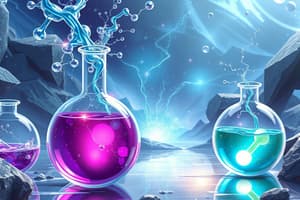Podcast
Questions and Answers
Which of the following best describes the primary function of energy materials?
Which of the following best describes the primary function of energy materials?
- To provide structural support in energy infrastructure.
- To insulate electrical components in high-energy systems.
- To facilitate the production, storage, and conversion of energy. (correct)
- To act as a catalyst in chemical reactions unrelated to energy.
What characteristic distinguishes crystalline solid electrolytes from amorphous solid electrolytes?
What characteristic distinguishes crystalline solid electrolytes from amorphous solid electrolytes?
- Crystalline electrolytes have lower ionic conductivity.
- Amorphous electrolytes possess a regular, ordered structure.
- Both have identical structural properties.
- Crystalline electrolytes typically have a higher ionic conductivity. (correct)
Which factor most significantly affects the conductivity of lithium-based solid electrolytes?
Which factor most significantly affects the conductivity of lithium-based solid electrolytes?
- The operating temperature of the device.
- The external pressure applied to the electrolyte.
- The concentration of lithium ions within the electrolyte. (correct)
- The presence of polymer additives.
According to the Nernst-Einstein equation, what relationship do the conductivity of an electrolyte, the mobility of ions, and the concentration of ions have?
According to the Nernst-Einstein equation, what relationship do the conductivity of an electrolyte, the mobility of ions, and the concentration of ions have?
How does the ionic mobility in liquid electrolytes compare to that in solid electrolytes?
How does the ionic mobility in liquid electrolytes compare to that in solid electrolytes?
What distinguishes superionic conductors from conventional solid electrolytes?
What distinguishes superionic conductors from conventional solid electrolytes?
Which of the following materials is commonly used in supercapacitors due to its high surface area and good electrical conductivity?
Which of the following materials is commonly used in supercapacitors due to its high surface area and good electrical conductivity?
What is a key advantage of using organic electrolytes over aqueous electrolytes in supercapacitors?
What is a key advantage of using organic electrolytes over aqueous electrolytes in supercapacitors?
What is the primary distinction between how supercapacitors and batteries store energy?
What is the primary distinction between how supercapacitors and batteries store energy?
Which characteristic of solid oxide fuel cells (SOFCs) presents both an advantage and a disadvantage?
Which characteristic of solid oxide fuel cells (SOFCs) presents both an advantage and a disadvantage?
Flashcards
Energy Materials
Energy Materials
Materials used in creation, storage, and conversion of energy; found in both fossil fuel and renewable energy systems.
Electrolytes
Electrolytes
Non-ohmic conductors used in electrochemical devices, existing as solid or liquid states.
Solid Electrolytes
Solid Electrolytes
Inorganic compounds that act as ion conductors in electrochemical devices, can be crystalline or amorphous.
Crystalline Solid Electrolytes
Crystalline Solid Electrolytes
Signup and view all the flashcards
Amorphous Solid Electrolytes
Amorphous Solid Electrolytes
Signup and view all the flashcards
Conductivity of Solid Electrolytes
Conductivity of Solid Electrolytes
Signup and view all the flashcards
Liquid Electrolytes
Liquid Electrolytes
Signup and view all the flashcards
Superionic Conductors
Superionic Conductors
Signup and view all the flashcards
Supercapacitors
Supercapacitors
Signup and view all the flashcards
Rechargeable Ion Batteries
Rechargeable Ion Batteries
Signup and view all the flashcards
Study Notes
- Energy materials are used in the production, storage, and conversion of energy, including those in fossil fuel and renewable energy systems.
Energy Materials in Traditional Fossil Fuel Systems
- Coal, natural gas, and oil are used as fuel sources.
- Carbon and graphite are used in the production of electrodes for batteries and fuel cells.
- Nickel and cobalt are used in the production of catalysts for refining oil and natural gas.
Energy Materials In Renewable Energy Systems
- Silicon is used in solar cells.
- Lithium, cobalt, and nickel are used in batteries for electric vehicles and energy storage.
- Rare earth elements are used in wind turbines.
- Biomass and biofuels are produced from plants and used as fuel sources.
Electrolytes
- Electrolytes are non-ohmic conductors used in electrochemical devices and are classified as solid or liquid based on their state.
Solid Electrolytes
- Solid electrolytes are inorganic compounds, acting as ion conductors in electrochemical devices like batteries, fuel cells, and sensors.
- Solid electrolytes are either crystalline or amorphous.
Crystalline Solid Electrolytes
- Crystalline solid electrolytes have a regular, ordered structure and higher conductivity than amorphous electrolytes.
- Examples include lithium fluoride (LiF), lithium iodide (LiI), and lithium thiophosphate (LiPS).
- Crystalline solid electrolytes are used in lithium batteries and high-temperature electrochemical devices.
Amorphous Solid Electrolytes
- Amorphous solid electrolytes lack long-range order and have lower conductivity compared to crystalline electrolytes.
- Examples include polyethylene oxide (PEO), polyvinylidene fluoride (PVDF), and lithium silicate (LiSi).
- Amorphous solid electrolytes are used in low-temperature electrochemical devices like sensors and batteries.
Importance of Solid Electrolytes
- Solid electrolytes improve the performance and safety of lithium-ion batteries, offering higher energy density, improved safety, and longer cycle life.
- Development faces challenges like low ionic conductivity and compatibility with battery fabrication.
Conductivity of Solid Electrolytes
- Conductivity measures a solid electrolyte's ability to conduct ions, typically lower than liquid electrolytes but higher than insulators.
- Factors affecting conductivity: temperature, composition, and microstructure.
- Conductivity generally increases with temperature, but the relationship is not always linear, and it can decrease at very high temperatures.
- Conductivity depends on lithium-ion concentration with conductivity increasing with higher concentration but can decrease at very high concentrations.
- Solid electrolytes with smaller grain sizes and fewer defects have higher conductivities.
- The Nernst-Einstein equation relates conductivity to the mobility and concentration of ions: σ = e * μ * c.
- Mobility (μ) is lower in solids than in liquids and the concentration (c) is lower in solid electrolytes as well.
Liquid Electrolytes and Conductivity
- A liquid electrolyte is a solution containing ions that conduct electricity, formed by dissolving a salt in a solvent.
- Examples: aqueous solutions (NaCl, H2SO4), organic solutions (propylene carbonate, ethylene carbonate in LiPF6), and room temperature ionic liquids (RTILs).
- Liquid electrolytes generally have higher conductivity than solid electrolytes due to greater ion mobility and lower viscosity.
- Factors affecting conductivity: temperature, concentration, and impurities with conductivity increasing with temperature, and higher ion concentration results in higher conductivity.
- Impurities can decrease conductivity by reducing ion mobility or forming barriers.
- Liquid electrolytes are used in batteries, fuel cells, sensors, electroplating, electrosynthesis, and water treatment.
- The conductivity of the liquid electrolyte is described by the Nernst-Einstein equation: σ = e * μ * c.
Superionic Conductors
- Superionic conductors are solid electrolytes with high ionic conductivity, typically in the range of 10-2 to 10-1 S/cm at room temperature.
- Ions move through the solid lattice as if in a liquid state, while electrons remain localized which is known as the superionic state.
- They consist of a metal cation (lithium, sodium) and a large anion (sulfur, selenium) such as Lithium sulfide (Li2S), Lithium selenide (Li2Se), Sodium sulfur (NaS), Calcium chloride (CaCl2)
- They can be used in batteries, fuel cells, and sensors, and are useful in high-temperature applications, and maintain high conductivity even at low temperatures.
Supercapacitors
- Supercapacitors/ultracapacitors store large amounts of electrical charge in a small volume, store and release electrical energy, and differ from batteries in energy storage mechanism.
- Supercapacitors store energy as electrical charge on the surface of electrodes, while batteries store energy in chemical form.
- Supercapacitors charge and discharge faster and withstand more charge-discharge cycles.
- Supercapacitors have lower energy density but higher power density than batteries.
- Applications include regenerative braking systems, electric vehicles, backup power systems, and portable electronics and can be used with batteries to improve energy storage systems.
- Supercapacitors are high-power capacitors that are an eco-friendly alternative to chemical batteries and meant to deliver a quick surge of power.
- Batteries store chemical energy and convert it into electrical energy
Materials for Supercapacitors
- Activated carbon has high surface area and good electrical conductivity and sourced from coconut shells, wood, or coal.
- Carbon aerogels have very high surface area made by sol-gel chemistry and results in them being porous and lightweight.
- Graphene has a very high surface area and excellent electrical conductivity.
- Metal oxides like nickel oxide (NiO) and titanium dioxide (TiO2) have high surface area, high charge storage, and good stability.
- Conductive polymers like polyaniline (PANI) and polypyrrole (PPy) have high conductivity and high chemical homogenity.
Electrolytes for Supercapacitors
- Supercapacitors use an electrolyte to provide a conductive medium for ion movement between electrodes.
- Aqueous electrolytes are solutions of water and a dissolved salt (sulfuric acid, potassium hydroxide, sodium hydroxide), have low viscosity, are inexpensive, but has a low operating voltage range.
- Organic electrolytes are solutions of an organic solvent and a dissolved salt (acetonitrile, propylene carbonate in lithium hexafluorophosphate), have higher viscosity than aqueous electrolytes, but a higher operating voltage range and better stability.
- Ionic liquids are a special class of electrolytes that remain liquid at room temperature, composed of organic cations and inorganic or organic anions, have high thermal stability and a wide electrochemical window, but are expensive and have high viscosity.
- Solid-state electrolytes conduct ions and examples include lithium sulfide, lithium selenide, sodium sulfur, and calcium chloride, have high conductivity and thermal stability, but are difficult to manufacture and have lower conductivity than liquid electrolytes.
Rechargeable Ion Batteries
- Rechargeable ion batteries, or secondary batteries, can be recharged with an electrical current, which allows them to be used repeatedly.
- Lithium-ion batteries are widely used in consumer electronics, consisting of a cathode (lithium cobalt oxide), an anode (graphite), and a liquid electrolyte.
- Lead-acid batteries are used in automobiles and backup power systems, consisting of lead electrodes and sulfuric acid electrolyte, and have low energy density but are inexpensive and have long service life.
- Other types include nickel-cadmium (NiCd), nickel-metal-hydride (NiMH), and sodium-ion batteries, each with unique properties.
Fuel Cells
- Fuel cells convert chemical energy from a fuel into electricity through a chemical reaction with oxygen or another oxidizing agent.
- They use a fuel source, an electrolyte, and two electrodes, and are used for transportation, power generation, and portable power.
- Good for clean and efficient power generation due to high efficiency and low emissions.
Solid Fuel Cells
- Solid fuel cells, or solid oxide fuel cells (SOFC), use a solid electrolyte (yttria-stabilized zirconia) that conducts ions at high temperatures.
- Fuel (natural gas, hydrogen) is oxidized at the anode to produce electrons and protons, electrons are conducted to the cathode side, where they recombine with the protons and oxygen to produce water and heat.
- High operating temperatures allow for high efficiency and low emissions and they can use a variety of fuels but require a expensive and complex membrane, which makes them more durable and reliable.
- High operating temperatures can lead to thermal stress and mechanical failure, and ceramic electrolytes can be brittle and difficult to manufacture.
Studying That Suits You
Use AI to generate personalized quizzes and flashcards to suit your learning preferences.




